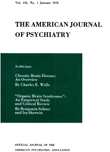THE CLINICAL INVESTIGATION AND DIFFERENTIAL MEASUREMENT OF ANXIETY
Abstract
1. Four clinical methods for rapid psychiatric evaluation and measurement of anxiety have been presented.
2. These methods investigate the effects of anxiety upon visuo-motor control, self-concept, level of aspiration, and body-image.
3. Typical results and differential trends obtained through these short procedures in psychiatric syndromes, characterized etiologically or symptomatically by anxiety, have been presented.
We conclude that in view of the primary importance of anxiety as psychopathogenic factor psychiatrists and medical students should acquaint themselves with objective, experimental methods, which can be used in the course of a clinical interview for the differential measurement and analysis of anxiety.
Access content
To read the fulltext, please use one of the options below to sign in or purchase access.- Personal login
- Institutional Login
- Sign in via OpenAthens
- Register for access
-
Please login/register if you wish to pair your device and check access availability.
Not a subscriber?
PsychiatryOnline subscription options offer access to the DSM-5 library, books, journals, CME, and patient resources. This all-in-one virtual library provides psychiatrists and mental health professionals with key resources for diagnosis, treatment, research, and professional development.
Need more help? PsychiatryOnline Customer Service may be reached by emailing [email protected] or by calling 800-368-5777 (in the U.S.) or 703-907-7322 (outside the U.S.).



